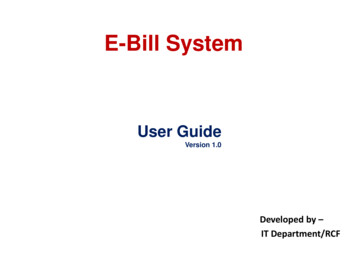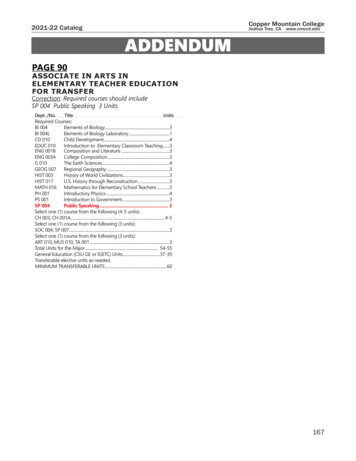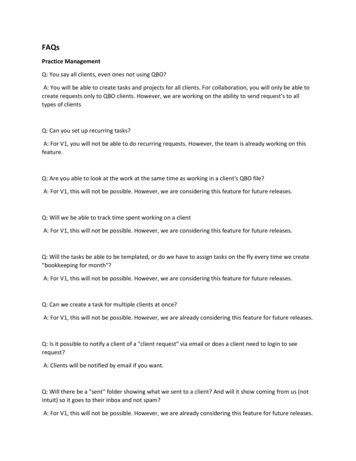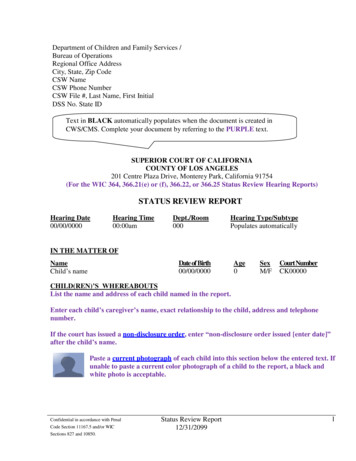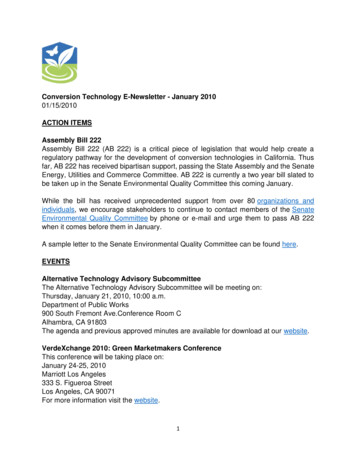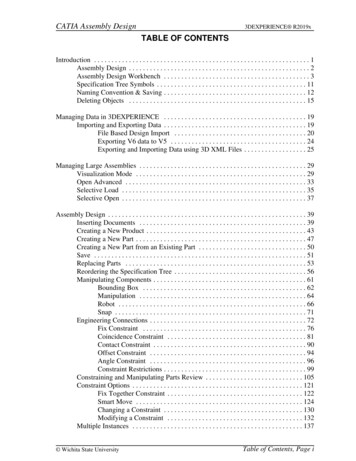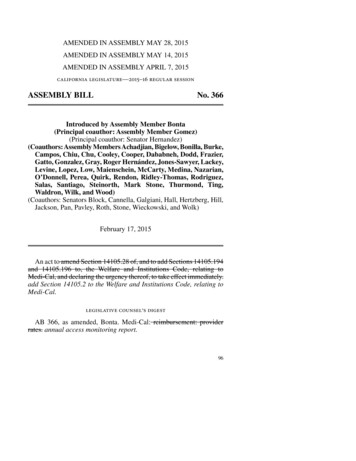
Transcription
AMENDED IN ASSEMBLY MAY 28, 2015AMENDED IN ASSEMBLY MAY 14, 2015AMENDED IN ASSEMBLY APRIL 7, 2015california legislature—2015–16 regular sessionASSEMBLY BILLNo. 366Introduced by Assembly Member Bonta(Principal coauthor: Assembly Member Gomez)(Principal coauthor: Senator Hernandez)(Coauthors: Assembly Members Achadjian, Bigelow, Bonilla, Burke,Campos, Chiu, Chu, Cooley, Cooper, Dababneh, Dodd, Frazier,Gatto, Gonzalez, Gray, Roger Hernández, Jones-Sawyer, Lackey,Levine, Lopez, Low, Maienschein, McCarty, Medina, Nazarian,O’Donnell, Perea, Quirk, Rendon, Ridley-Thomas, Rodriguez,Salas, Santiago, Steinorth, Mark Stone, Thurmond, Ting,Waldron, Wilk, and Wood)(Coauthors: Senators Block, Cannella, Galgiani, Hall, Hertzberg, Hill,Jackson, Pan, Pavley, Roth, Stone, Wieckowski, and Wolk)February 17, 2015An act to amend Section 14105.28 of, and to add Sections 14105.194and 14105.196 to, the Welfare and Institutions Code, relating toMedi-Cal, and declaring the urgency thereof, to take effect immediately.add Section 14105.2 to the Welfare and Institutions Code, relating toMedi-Cal.legislative counsel’s digestAB 366, as amended, Bonta. Medi-Cal: reimbursement: providerrates. annual access monitoring report.96
AB 366—2—Existing law establishes the Medi-Cal program, administered by theState Department of Health Care Services, under which health careservices are provided to qualified, low-income persons. The Medi-Calprogram is, in part, governed and funded by federal Medicaid Programprovisions. Under the federal Patient Protection and Affordable CareAct, existing state law extends Medi-Cal eligibility to childless adultsunder 65 years of age.This bill would require the State Department of Health Care Services,by March 15, 2016, and annually thereafter by February 1, to submitto the Legislature, and post on the department’s Internet Web site, aMedi-Cal access monitoring report providing an assessment of accessto care in Medi-Cal and identifying a basis to evaluate the adequacyof Medi-Cal reimbursement rates and the existence of other barriersto access to care, as specified. The bill would require the departmentto hold a public meeting to present and discuss the access monitoringreport at least once annually, and would require the department toaccept public comment from stakeholders at the public meeting. Thebill would authorize the department to enter into an interagencyagreement with the University of California to perform an ongoingassessment of access to care and the adequacy of provider paymentsin Medi-Cal. The bill would require, to the extent funding is providedin the annual Budget Act and federal financial participation is available,rate increases to be implemented for services, provider types, orgeographic areas for which rates are identified in the annual report asinadequate.(1) Existing law establishes the Medi-Cal program, administered bythe State Department of Health Care Services, under which health careservices are provided to qualified, low-income persons. The Medi-Calprogram is, in part, governed and funded by federal Medicaid provisions.Existing law requires the department to develop and implement aMedi-Cal inpatient hospital reimbursement payment methodology basedon diagnosis-related groups, subject to federal approval, that reflectsthe costs and staffing levels associated with quality of care for patientsin all general acute care hospitals, as specified. Existing law generallyrequires the diagnosis-related group-based payments to apply to allclaims.This bill would require claims for payments pursuant to the inpatienthospital reimbursement methodology described above to be increasedby 16% for the 2015–16 fiscal year, and would require, commencingJuly 1, 2016, and annually thereafter, the department to increase each96
—3—AB 366diagnosis-related group payment claim amount based, at a minimum,on increases in the medical component of the California ConsumerPrice Index. Commencing with the 2015–16 fiscal year, and annuallythereafter, the bill would require managed care rates for Medi-Calmanaged care health plans to be increased by a proportionately equalamount for increased payments for hospital services.(2) Existing law requires, except as otherwise provided, Medi-Calprovider payments to be reduced by 1% or 5%, and provider paymentsfor specified non-Medi-Cal programs to be reduced by 1%, for datesof service on and after March 1, 2009, and until June 1, 2011. Existinglaw requires, except as otherwise provided, Medi-Cal provider paymentsand payments for specified non-Medi-Cal programs to be reduced by10% for dates of service on and after June 1, 2011.This bill would, instead, prohibit the application of those reductionsfor payments to providers for dates of service on or after June 1, 2011.The bill would also require payments for managed care health plans fordates of service following the effective date of the bill to be determinedwithout application of some of those reductions. The bill would requirethe Director of Health Care Services to implement this provision to themaximum extent permitted by federal law and for the maximum timeperiod for which the director obtains federal approval for federalfinancial participation for those payments.(3) Prior law required, beginning January 1, 2013, through andincluding December 31, 2014, that payments for primary care servicesprovided by specified physicians be no less than 100% of the paymentrate that applies to those services and physicians as established by theMedicare program, for both fee-for-service and managed care plans.This bill, commencing January 1, 2016, would require, only to theextent permitted by federal law and that federal financial participationis available, payments for specified medical care services to not be lessthan 100% of the payment rate that applies to those services asestablished by the Medicare program for services rendered byfee-for-service providers, and would require rates paid to Medi-Calmanaged care plans to be actuarially equivalent to payment ratesestablished by the Medicare program. The bill would authorize thedepartment to implement those provisions through provider bulletinswithout taking regulatory action until regulations are adopted, and wouldrequire the department to adopt those regulations by July 1, 2018. Thebill would require, commencing July 1, 2016, the department to provide96
AB 366—4—a status report to the Legislature on a semiannual basis until regulationshave been adopted.(4) This bill would declare that it is to take effect immediately as anurgency statute.Vote: 2 3 majority. Appropriation: no. Fiscal committee: yes.State-mandated local program: no.The people of the State of California do enact as follows:line 1line 2line 3line 4line 5line 6line 7line 8line 9line 10line 11line 12line 13line 14line 15line 16line 17line 18line 19line 20line 21line 22line 23line 24line 25line 26line 27line 28line 29line 30line 31SECTION 1. Section 14105.2 is added to the Welfare andInstitutions Code, to read:14105.2. (a) The Legislature finds and declares all of thefollowing:(1) California has significantly reduced the number of uninsuredpersons by expanding the Medi-Cal program under the federalPatient Protection and Affordable Care Act (Public Law 111-148).(2) It is important to ensure adequate access to care in theMedi-Cal program as new enrollees seek appropriate care.(3) The state needs to assess the gaps in access to care and actswiftly to address those gaps.(4) One area of anticipated need is the availability of moreMedi-Cal providers.(5) California’s Medi-Cal provider reimbursement rates havehistorically been among the lowest in the nation.(6) During recent years, the state has reduced reimbursementrates to Medi-Cal providers due to budget constraints.(7) An assessment of gaps in access should include adetermination of whether current provider rates are sufficient toensure access to care.(b) Therefore, it is the intent of the Legislature that an annualaccess monitoring report provide a valid, clear, and publicassessment of access to care in Medi-Cal, and provide a basis toevaluate the adequacy of Medi-Cal rates and the existence of otherbarriers to access to care.(c) Notwithstanding Section 10231.5 of the Government Code,by March 15, 2016, and annually thereafter by February 1, thedepartment shall submit to the Legislature, and post on thedepartment’s Internet Web site, a Medi-Cal access monitoringreport. The report shall be submitted in compliance with Section9795 of the Government Code. The annual report shall:96
—5—line 1line 2line 3line 4line 5line 6line 7line 8line 9line 10line 11line 12line 13line 14line 15line 16line 17line 18line 19line 20line 21line 22line 23line 24line 25line 26line 27line 28line 29line 30line 31line 32line 33line 34line 35line 36line 37line 38line 39AB 366(1) Present results of the department’s ongoing accessmonitoring efforts in fee-for-service and managed care. Formanaged care, the report shall include results from the Departmentof Managed Health Care’s oversight of provider networks andtimely access in Medi-Cal managed care.(2) Compare the level of access to care and services availablethrough Medi-Cal, to the level of access to care and servicesavailable to the general population in different geographic areasof California.(3) Include access measurements of sufficient granularity toreflect patient experience of access to particular services orprovider types, or in particular geographic areas.(4) Identify particular services, provider types, or geographicareas for which the level of access is less than the level of accessto care and services available to the general population in thegeographic area. For those services, provider types, or geographicareas, the annual report shall assess and report on the adequacyof provider payment rates and identify any other factors thatimpede access.(5) Use language clearly understandable to the public.(6) Use more than one valid, generally accepted method toassess access to care.(d) At least once annually, the department shall hold a publicmeeting to present and discuss the access monitoring report. Thedepartment shall accept public comment from stakeholders at thepublic meeting.(e) The department may enter into an interagency agreementwith the University of California to perform an ongoing assessmentof access to care and the adequacy of provider payment rates inMedi-Cal.(f) For services, provider types, or geographic areas for whichrates are identified in the annual report as inadequate, rateincreases shall be implemented to the extent funding is providedin the annual Budget Act and federal financial participation isavailable.SECTION 1. Section 14105.28 of the Welfare and InstitutionsCode is amended to read:14105.28. (a) It is the intent of the Legislature to design a newMedi-Cal inpatient hospital reimbursement methodology based96
AB 366line 1line 2line 3line 4line 5line 6line 7line 8line 9line 10line 11line 12line 13line 14line 15line 16line 17line 18line 19line 20line 21line 22line 23line 24line 25line 26line 27line 28line 29line 30line 31line 32line 33line 34line 35line 36line 37line 38line 39line 40—6—on diagnosis-related groups that more effectively ensures all ofthe following:(1) Encouragement of access by setting higher payments forpatients with more serious conditions.(2) Rewards for efficiency by allowing hospitals to retainsavings from decreased length of stays and decreased costs perday.(3) Improvement of transparency and understanding by definingthe “product” of a hospital in a way that is understandable to bothclinical and financial managers.(4) Improvement of fairness so that different hospitals receivesimilar payment for similar care and payments to hospitals areadjusted for significant cost factors that are outside the hospital’scontrol.(5) Encouragement of administrative efficiency and minimizingadministrative burdens on hospitals and the Medi-Cal program.(6) That payments depend on data that has high consistency andcredibility.(7) Simplification of the process for determining and makingpayments to the hospitals.(8) Facilitation of improvement of quality and outcomes.(9) Facilitation of implementation of state and federal provisionsrelated to hospital acquired conditions.(10) Support of provider compliance with all applicable stateand federal requirements.(b) (1) (A) (i) The department shall develop and implementa payment methodology based on diagnosis-related groups, subjectto federal approval, that reflects the costs and staffing levelsassociated with quality of care for patients in all general acute carehospitals in state and out of state, including Medicare critical accesshospitals, but excluding public hospitals, psychiatric hospitals,and rehabilitation hospitals, which include alcohol and drugrehabilitation hospitals.(ii) The payment methodology developed pursuant to this sectionshall be implemented on July 1, 2012, or on the date upon whichthe director executes a declaration certifying that all necessaryfederal approvals have been obtained and the methodology issufficient for formal implementation, whichever is later.(iii) Claims for payments pursuant to the payment methodologybased on diagnosis-related groups established under this section96
—7—line 1line 2line 3line 4line 5line 6line 7line 8line 9line 10line 11line 12line 13line 14line 15line 16line 17line 18line 19line 20line 21line 22line 23line 24line 25line 26line 27line 28line 29line 30line 31line 32line 33line 34line 35line 36line 37line 38line 39AB 366shall be increased by 16 percent for the 2015–16 fiscal year.Managed care rates to Medi-Cal managed care health plans shallbe increased by a proportionately equal amount for increasedpayments for hospital services for the 2015–16 fiscal year.(iv) Commencing July 1, 2016, and annually thereafter, thedepartment shall increase each diagnosis-related group paymentclaim amount based, at a minimum, on increases in the medicalcomponent of the California Consumer Price Index. CommencingJuly 1, 2016, and annually thereafter, managed care rates toMedi-Cal managed care health plans shall be increased by aproportionately equal amount for increased payments for hospitalservices.(B) The diagnosis-related group-based payments shall apply toall claims, except claims for psychiatric inpatient days,rehabilitation inpatient days, managed care inpatient days, andswing bed stays for long-term care services, provided, however,that psychiatric and rehabilitation inpatient days shall be excludedregardless of whether the stay was in a distinct-part unit. Thedepartment may exclude or include other claims and services asmay be determined during the development of the paymentmethodology.(C) Implementation of the new payment methodology shall becoordinated with the development and implementation of thereplacement Medicaid Management Information System pursuantto the contract entered into pursuant to Section 14104.3, effectiveon May 3, 2010.(2) The department shall evaluate alternative diagnosis-relatedgroup algorithms for the new Medi-Cal reimbursement system forthe hospitals to which paragraph (1) applies. The evaluation shallinclude, but not be limited to, consideration of all of the followingfactors:(A) The basis for determining diagnosis-related group baseprice, and whether different base prices should be used taking intoaccount factors such as geographic location, hospital size, teachingstatus, the local hospital wage area index, and any other variablesthat may be relevant.(B) Classification of patients based on appropriate acuityclassification systems.(C) Hospital case mix factors.96
AB 366line 1line 2line 3line 4line 5line 6line 7line 8line 9line 10line 11line 12line 13line 14line 15line 16line 17line 18line 19line 20line 21line 22line 23line 24line 25line 26line 27line 28line 29line 30line 31line 32line 33line 34line 35line 36line 37line 38line 39line 40—8—(D) Geographic or regional differences in the cost of operatingfacilities and providing care.(E) Payment models based on diagnosis-related groups used inother states.(F) Frequency of group updates for the diagnosis-related groups.(G) The extent to which the particular grouping algorithm forthe diagnosis-related groups accommodates ICD-10 diagnosis andprocedure codes, and applicable requirements of the federal HealthInsurance Portability and Accountability Act of 1996 (Public Law104-191).(H) The basis for calculating relative weights for the variousdiagnosis-related groups.(I) Whether policy adjusters should be used, for which carecategories they should be used, and the frequency of updates tothe policy adjusters.(J) The extent to which the payment system is budget neutraland can be expected to result in state budget savings in futureyears.(K) Other factors that may be relevant to determining payments,including, but not limited to, add-on payments, outlier payments,capital payments, payments for medical education, payments inthe case of early transfers of patients, and payments based onperformance and quality of care.(c) The department shall submit to the Legislature a status reporton the implementation of this section on April 1, 2011, April 1,2012, April 1, 2013, and April 1, 2014.(d) The alternatives for a new system described in paragraph(2) of subdivision (b) shall be developed in consultation withrecognized experts with experience in hospital reimbursement,economists, the federal Centers for Medicare and MedicaidServices, and other interested parties.(e) In implementing this section, the department may contract,as necessary, on a bid or nonbid basis, for professional consultingservices from nationally recognized higher education and researchinstitutions, or other qualified individuals and entities notassociated with a particular hospital or hospital group, withdemonstrated expertise in hospital reimbursement systems. Therate setting system described in subdivision (b) shall be developedwith all possible expediency. This subdivision establishes anaccelerated process for issuing contracts pursuant to this section96
—9—line 1line 2line 3line 4line 5line 6line 7line 8line 9line 10line 11line 12line 13line 14line 15line 16line 17line 18line 19line 20line 21line 22line 23line 24line 25line 26line 27line 28line 29line 30line 31line 32line 33line 34line 35line 36line 37line 38line 39line 40AB 366and contracts entered into pursuant to this subdivision shall beexempt from the requirements of Chapter 1 (commencing withSection 10100) and Chapter 2 (commencing with Section 10290)of Part 2 of Division 2 of the Public Contract Code.(f) (1) The department may adopt emergency regulations toimplement the provisions of this section in accordance withrulemaking provisions of the Administrative Procedure Act(Chapter 3.5 (commencing with Section 11340) of Part 1 ofDivision 3 of Title 2 of the Government Code). The initial adoptionof emergency regulations and one readoption of the initialregulations shall be deemed to be an emergency and necessary forthe immediate preservation of the public peace, health and safety,or general welfare. Initial emergency regulations and the onereadoption of those regulations shall be exempt from review bythe Office of Administrative Law. The initial emergencyregulations and the one readoption of those regulations authorizedby this section shall be submitted to the Office of AdministrativeLaw for filing with the Secretary of State and publication in theCalifornia Code of Regulations.(2) As an alternative to paragraph (1), and notwithstanding therulemaking provisions of Chapter 3.5 (commencing with Section11340) of Part 1 of Division 3 of Title 2 of the Government Code,or any other law, the department may implement and administerthis section by means of provider bulletins, all-county letters,manuals, or other similar instructions, without taking regulatoryaction. The department shall notify the fiscal and appropriate policycommittees of the Legislature of its intent to issue a providerbulletin, all-county letter, manual, or other similar instruction, atleast five days prior to issuance. In addition, the department shallprovide a copy of any provider bulletin, all-county letter, manual,or other similar instruction issued under this paragraph to the fiscaland appropriate policy committees of the Legislature.SEC. 2. Section 14105.194 is added to the Welfare andInstitutions Code, to read:14105.194. (a) Notwithstanding Sections 14105.07, 14105.191,14105.192, and 14105.193, payments to providers for dates ofservice on or after June 1, 2011, shall be determined withoutapplication of the reductions in Sections 14105.07, 14105.191,14105.192, and 14105.193, except as otherwise provided in thissection.96
AB 366line 1line 2line 3line 4line 5line 6line 7line 8line 9line 10line 11line 12line 13line 14line 15line 16line 17line 18line 19line 20line 21line 22line 23line 24line 25line 26line 27line 28line 29line 30line 31line 32line 33line 34line 35line 36line 37line 38line 39line 40— 10 —(b) Notwithstanding Sections 14105.07 and 14105.192, andexcept as otherwise provided in this section, for managed carehealth plans that contract with the department pursuant to thischapter or Chapter 8 (commencing with Section 14200), paymentsfor dates of service following the effective date of the act addingthis section shall be determined without application of thereductions, limitations, and adjustments in Sections 14105.07 and14105.192.(c) The director shall implement this section to the maximumextent permitted by federal law and for the maximum time periodfor which the director obtains federal approval for federal financialparticipation for the payments provided for in this section.(d) The director shall promptly seek all necessary federalapprovals to implement this section.SEC. 3. Section 14105.196 is added to the Welfare andInstitutions Code, to read:14105.196. (a) It is the intent of the Legislature to:(1) Maintain the increased reimbursement rates for primary careproviders in the Medi-Cal program upon expiration of thetemporary increase provided for under Chapter 23 of the Statutesof 2012, as amended by Chapter 438 of the Statutes of 2012, inorder to ensure adequate access to these providers.(2) Increase reimbursement rates for other Medi-Cal providersto the amounts reimbursed by the federal Medicare program inorder to ensure access to medically necessary health care services,and to comply with federal Medicaid requirements that care andservices are available to Medi-Cal enrollees at least to the extentthat care and services are available to the general population inthe geographic area.(3) Increase reimbursement rates for Denti-Cal providers to theequivalent rate of the percentage increase for other Medi-Calproviders to the amounts reimbursed by the federal Medicareprogram in order to ensure access to medically necessary dentalservices, and to comply with federal Medicaid requirements thatcare and services are available to Medi-Cal enrollees at least tothe extent that care and services are available to the generalpopulation in the geographic area.(b) (1) (A) Commencing January 1, 2016, payments for medicalcare services rendered by fee-for-service Medi-Cal providers,including dental providers, shall not be less than 100 percent of96
— 11 —line 1line 2line 3line 4line 5line 6line 7line 8line 9line 10line 11line 12line 13line 14line 15line 16line 17line 18line 19line 20line 21line 22line 23line 24line 25line 26line 27line 28line 29line 30line 31line 32line 33line 34line 35line 36line 37line 38line 39line 40AB 366the payment rate that applies to those services as established bythe Medicare program for services rendered by fee-for-serviceproviders.(B) Commencing January 1, 2016, rates paid to Medi-Calmanaged care plans shall be actuarially equivalent to the paymentrate established under the Medicare program.(2) This subdivision shall be implemented only to the extentpermitted by federal law and regulations.(c) Notwithstanding any other law, to the extent permitted byfederal law and regulations, the payments for medical care servicesmade pursuant to this section shall be exempt from the paymentreductions under Sections 14105.191 and 14105.192.(d) Payment increases made pursuant to this section shall notapply to provider rates of payment described in Section 14105.18for services provided to individuals not eligible for Medi-Cal orthe Family Planning, Access, Care, and Treatment (Family PACT)Program.(e) For purposes of this section, “medical care services” meansthe services identified in subdivisions (a), (h), (i), (j), (n), (q), and(w) of Section 14132, and adult dental benefits provided pursuantto Section 14131.10.(f) Notwithstanding any other law, the department shallimplement the payment increase required by this section tomanaged care health plans that contract pursuant to Chapter 8.75(commencing with Section 14591) and to contracts with the SeniorCare Action Network and the AIDS Healthcare Foundation in thefollowing manner, to the extent that the services are providedthrough any of these contracts, payments by the department tomanaged care health plans shall be increased by the actuariallyequivalent amount of the payment increases pursuant to contractamendments or change orders effective on or after January 1, 2016.(g) Notwithstanding Chapter 3.5 (commencing with Section11340) of Part 1 of Division 3 of Title 2 of the Government Code,the department shall implement, clarify, make specific, and definethe provisions of this section by means of provider bulletins orsimilar instructions, without taking regulatory action until the timeregulations are adopted. The department shall adopt regulationsby July 1, 2018, in accordance with the requirements of Chapter3.5 (commencing with Section 11340) of Part 1 of Division 3 ofTitle 2 of the Government Code. Beginning July 1, 2016, and96
AB 366line 1line 2line 3line 4line 5line 6line 7line 8line 9line 10line 11line 12line 13line 14— 12 —notwithstanding Section 10231.5 of the Government Code, thedepartment shall provide a status report to the Legislature on asemiannual basis, in compliance with Section 9795 of theGovernment Code, until regulations have been adopted.(h) This section shall be implemented only if and to the extentthat federal financial participation is available and any necessaryfederal approvals have been obtained.SEC. 4. This act is an urgency statute necessary for theimmediate preservation of the public peace, health, or safety withinthe meaning of Article IV of the Constitution and shall go intoimmediate effect. The facts constituting the necessity are:In order to ensure, at the earliest possible time, access tomedically necessary care for Medi-Cal beneficiaries, it is necessarythat this act take effect immediately.O96
line 1 (1) Present results of the department's ongoing access line 2 monitoring efforts in fee-for-service and managed care.For line 3 mana ged car e, the r eport shall include r esults fr om the Department line 4 of Managed Health Care's oversight of provider networks and line 5 timely access in Medi-Cal managed care. line 6 (2) Compare the level of access to care and services available
